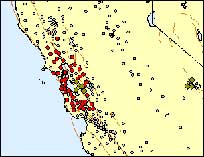|
"P" or primary waves are the fastest kind of seismic
wave -- the ones felt first when an earthquake occurs. Their 10-12
second warning before major shaking begins may provide just enough
time to prevent at least some of the destruction caused when a
temblor hits.
 Seconds
may not seem like much of a warning, but in that time, shut-off
valves in oil refineries can be activated, surgeons can suspend
delicate operations, even fire station doors can automatically
swing open, said Mary Lou Zoback, a research geologist with the
U.S. Geological Survey. Seconds
may not seem like much of a warning, but in that time, shut-off
valves in oil refineries can be activated, surgeons can suspend
delicate operations, even fire station doors can automatically
swing open, said Mary Lou Zoback, a research geologist with the
U.S. Geological Survey.
Some countries, including Japan and Mexico, have installed an
early warning system of seismic sensors, according to Richard
Allen, an assistant professor at the Berkeley Seismology Laboratory
and the point person for a possible similar system in the United
States.
The countries with the early warning system have not experienced
major earthquakes since the systems were installed, so they have
yet to undergo real life tests, said Allen.
In the United States, a group at the University of California,
Berkeley, is working on a model for California and plans to conduct
tests later in 2006 with either the smaller earthquakes that occur
all the time or a synthetic quake, he said.
California is already taking long-term approaches to earthquake
damage mitigation, such as enforcing strengthened building codes,
but the early-warning system provides an additional useful short-term
approach, he added.
Earthquake Alarm
Systems: More information on early-warning detection
-- By Larisa Epatko, Online
NewsHour
|





